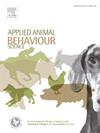Olfactory awareness in lambs assessed through habituation-dishabituation and approach-withdrawal tests
IF 2
2区 农林科学
Q1 AGRICULTURE, DAIRY & ANIMAL SCIENCE
引用次数: 0
Abstract
Assessing olfaction in lambs presents methodological challenges due to their precocial development and extreme sensitivity to isolation and novelty. Previous research studied lambs’ olfactory reactivity, particularly to odors from conspecifics, their responses to other odor sources remaining underexplored. To begin addressing this gap, we implemented two tests to evaluate olfactory discrimination in lambs using two distinct odors: dog feces odor (DO) and ovine wool odor (OO). First, after validating the procedure on 10 Suffolk ewes with the same odorous stimuli, a habituation-dishabituation (H-D) test run on 6-day-old lambs (Suffolk, n = 26, 14 females) consisted in repeating 4 times one odor for habituation, followed by a single presentation the other, novel odor for dishabituation (presentation order of OO/DO being counterbalanced across animals). The ewes and lambs habituated to both odors, exhibiting a significant decline in sniffing duration; they also dishabituated to novel odors, attesting their clear discrimination between them. Second, an approach-withdrawal test using boxes scented with these same stimuli was run a group of lambs p (Suffolk, age: 24-day, n = 21). In the approach test, lambs spent significantly more time near objects scented with unfamiliar conspecific wool than those scented with canine feces. Both tests confirmed that lambs clearly discriminate both odors. While the habituation-dishabituation test proved effective in assessing odor discrimination, interpretation of the approach test results was more complex under the given experimental conditions.
通过适应-不适应和接近-戒断测试评估羔羊的嗅觉意识
评估羔羊的嗅觉提出了方法学上的挑战,因为它们发育过早,对隔离和新鲜事物极度敏感。先前的研究研究了羔羊的嗅觉反应,特别是对同种气味的反应,但它们对其他气味来源的反应仍未得到充分研究。为了解决这一差距,我们实施了两个测试,使用两种不同的气味来评估羔羊的嗅觉辨别:狗屎气味(DO)和羊羊毛气味(OO)。首先,在对10只具有相同气味刺激的萨福克母羊进行验证后,对6日龄羔羊(萨福克,n = 26,14只母羊)进行了适应-不适应(H-D)测试,其中包括重复4次一种气味进行适应,然后再进行另一种新气味的不适应(OO/DO的呈现顺序在动物之间进行平衡)。母羊和羔羊习惯了这两种气味,嗅闻的持续时间显著下降;它们对新奇的气味也不习惯,这证明它们对它们有明显的区别。其次,使用带有相同刺激物气味的盒子对一组羔羊p(萨福克,年龄:24天,n = 21)进行了接近-退缩测试。在接近测试中,羔羊在带有不熟悉的同种羊毛气味的物体上花费的时间明显多于那些带有犬粪气味的物体。两项测试都证实,羊羔能清楚地分辨出两种气味。虽然习惯-非习惯测试在评估气味辨别方面被证明是有效的,但在给定的实验条件下,接近测试结果的解释更为复杂。
本文章由计算机程序翻译,如有差异,请以英文原文为准。
求助全文
约1分钟内获得全文
求助全文
来源期刊

Applied Animal Behaviour Science
农林科学-行为科学
CiteScore
4.40
自引率
21.70%
发文量
191
审稿时长
18.1 weeks
期刊介绍:
This journal publishes relevant information on the behaviour of domesticated and utilized animals.
Topics covered include:
-Behaviour of farm, zoo and laboratory animals in relation to animal management and welfare
-Behaviour of companion animals in relation to behavioural problems, for example, in relation to the training of dogs for different purposes, in relation to behavioural problems
-Studies of the behaviour of wild animals when these studies are relevant from an applied perspective, for example in relation to wildlife management, pest management or nature conservation
-Methodological studies within relevant fields
The principal subjects are farm, companion and laboratory animals, including, of course, poultry. The journal also deals with the following animal subjects:
-Those involved in any farming system, e.g. deer, rabbits and fur-bearing animals
-Those in ANY form of confinement, e.g. zoos, safari parks and other forms of display
-Feral animals, and any animal species which impinge on farming operations, e.g. as causes of loss or damage
-Species used for hunting, recreation etc. may also be considered as acceptable subjects in some instances
-Laboratory animals, if the material relates to their behavioural requirements
 求助内容:
求助内容: 应助结果提醒方式:
应助结果提醒方式:


